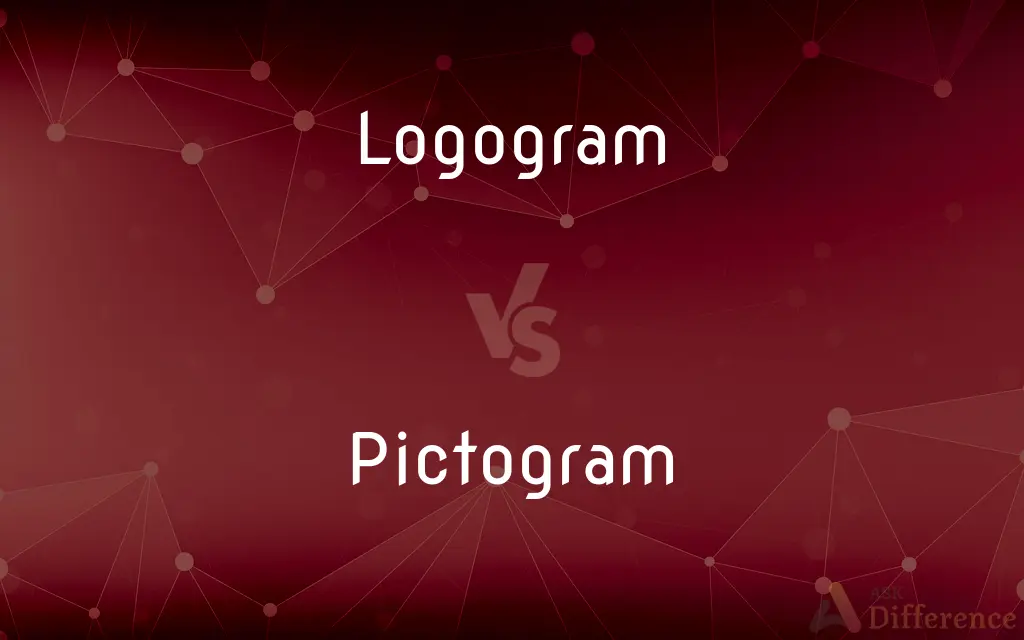Logogram vs. Pictogram — What's the Difference?
Edited by Tayyaba Rehman — By Urooj Arif — Updated on March 18, 2024
Logogram and Pictogram both represent ideas, but logograms are symbols for words or parts of words, whereas pictograms depict objects or concepts visually.

Difference Between Logogram and Pictogram
Table of Contents
ADVERTISEMENT
Key Differences
Logograms are symbolic representations used in writing systems to denote whole words or morphemes, the smallest meaningful units in a language. Pictograms, on the other hand, are icons or drawings that represent objects, actions, or concepts through a visual similarity to the thing they depict.
While logograms require knowledge of the language and its writing system to understand their meaning, pictograms aim to be more immediately recognizable, even to those unfamiliar with the language. For example, a logogram in the Chinese language may not be understood by a non-speaker, whereas a pictogram of a man running could be universally understood as an indication to exit or to proceed with caution.
The use of logograms in writing systems allows for a compact and efficient mode of communication, particularly beneficial for languages with a large number of morphemes, like Chinese. In contrast, pictograms are used more for their universal clarity in conveying simple concepts or instructions without the need for written language.
Both logograms and pictograms play crucial roles in communication, but their applications and the clarity they provide differ. Logograms are integral to the structure of certain languages and require learning and understanding of that language to decode. Pictograms, while possibly less detailed in the information they convey, offer a more immediate, language-independent form of communication.
Comparison Chart
Definition
Symbol representing a word or morpheme
Icon depicting objects or concepts visually
ADVERTISEMENT
Use in Language
Requires understanding of specific language
Designed to be universally understood
Example
Chinese characters
Airport signs
Main Purpose
Efficient communication in complex writing systems
Immediate recognition across language barriers
Interpretation
Language and context-specific
Generally intuitive and universal
Compare with Definitions
Logogram
A symbol representing a word or a part of a word.
The Chinese character for tree is a logogram that represents the concept of a tree.
Pictogram
Widely used for public signs and information.
Pictograms on road signs communicate information quickly and effectively to drivers from any linguistic background.
Logogram
Used extensively in languages with complex writing systems.
In Egyptian hieroglyphics, logograms were used to represent both the sounds and the objects they depicted.
Pictogram
Facilitates immediate recognition.
Emergency exit pictograms provide an instant visual cue for quick response.
Logogram
Often carries historical and cultural significance.
Many logograms in ancient writing systems are derived from artistic representations of cultural symbols.
Pictogram
Less influenced by cultural differences.
Pictograms for common objects or actions tend to be universally recognized, transcending cultural and language barriers.
Logogram
Requires knowledge of the specific language to understand.
Learning Japanese kanji, a form of logogram, requires memorization and understanding of thousands of characters.
Pictogram
A pictorial symbol for a word or phrase.
The pictogram for a bathroom is universally recognized without the need for text.
Logogram
Allows for compact expression of ideas.
A single logogram can convey the meaning of a whole word or concept, making written communication more efficient.
Pictogram
Designed to be intuitively understood.
Children can understand many pictograms before they can read text.
Logogram
In a written language, a logogram or logograph is a written character that represents a word or morpheme. Chinese characters (pronounced hanzi in Mandarin, kanji in Japanese, hanja in Korean and Hán tự in Vietnamese) are generally logograms, as are many hieroglyphic and cuneiform characters.
Pictogram
A pictogram, also called a pictogramme, pictograph, or simply picto, and in computer usage an icon, is a graphic symbol that conveys its meaning through its pictorial resemblance to a physical object. Pictographs are often used in writing and graphic systems in which the characters are to a considerable extent pictorial in appearance.
Logogram
A written symbol representing an entire spoken word without expressing its pronunciation; for example, for 4 read "four" in English, "quattro" in Italian. Also called ideogram, logograph.
Pictogram
See pictograph.
Logogram
A character or symbol (usually nonalphanumeric) that represents a word or phrase.
Pictogram
A picture that represents a word or an idea by illustration.
Logogram
A kind of word puzzle: a logogriph.
Logogram
A word letter; a phonogram, that, for the sake of brevity, represents a word; as, |, i. e., t, for it. Cf. Grammalogue.
Logogram
A single written symbol that represents an entire word or phrase without indicating its pronunciation;
7 is a logogram that is pronounced `seven' in English and `nanatsu' in Japanese
Common Curiosities
What is a logogram?
A logogram is a written character that represents a word or morpheme.
How do logograms differ from pictograms in purpose?
Logograms are used in specific language writing systems to represent words or parts of words, whereas pictograms represent ideas through visual similarity, aiming for universal understanding.
Are logograms language-specific?
Yes, logograms are specific to the languages and writing systems in which they are used.
Where might one commonly find pictograms?
Pictograms are commonly found in public signs, instructions, and informational labels.
What is a pictogram?
A pictogram is a pictorial symbol that represents an object, action, or concept.
Do logograms convey meaning more efficiently than alphabetic writing?
In some contexts, yes, because they can represent complex ideas or words with a single character.
Can logograms and pictograms be combined in communication?
Yes, in some contexts, such as instructional materials or bilingual signage, they can be used together to enhance understanding.
Can anyone understand a pictogram?
Pictograms are designed to be as universally understandable as possible, though cultural differences can sometimes influence interpretation.
Can pictograms be used in any language?
Yes, pictograms are designed to be understood universally, across languages.
Do logograms have phonetic components?
Some logograms also include elements that suggest their pronunciation, especially in languages like Japanese.
Are pictograms effective for complex communication?
Pictograms are most effective for simple, universally recognized concepts rather than complex communication.
How old are the practices of using logograms and pictograms?
Both practices are ancient, with roots in the earliest human civilizations and writing systems.
What's the primary advantage of using pictograms in international contexts?
Their main advantage is the ability to communicate essential information across language barriers without the need for translation.
How are logograms learned?
Learning logograms involves memorization and understanding of their specific meanings within a language's writing system.
Why are pictograms used in emergency signs?
Because they convey important information quickly and can be understood by people regardless of their language proficiency.
Share Your Discovery

Previous Comparison
Ermine vs. Stoat
Next Comparison
Tram vs. TrolleyAuthor Spotlight
Written by
Urooj ArifUrooj is a skilled content writer at Ask Difference, known for her exceptional ability to simplify complex topics into engaging and informative content. With a passion for research and a flair for clear, concise writing, she consistently delivers articles that resonate with our diverse audience.
Edited by
Tayyaba RehmanTayyaba Rehman is a distinguished writer, currently serving as a primary contributor to askdifference.com. As a researcher in semantics and etymology, Tayyaba's passion for the complexity of languages and their distinctions has found a perfect home on the platform. Tayyaba delves into the intricacies of language, distinguishing between commonly confused words and phrases, thereby providing clarity for readers worldwide.














































